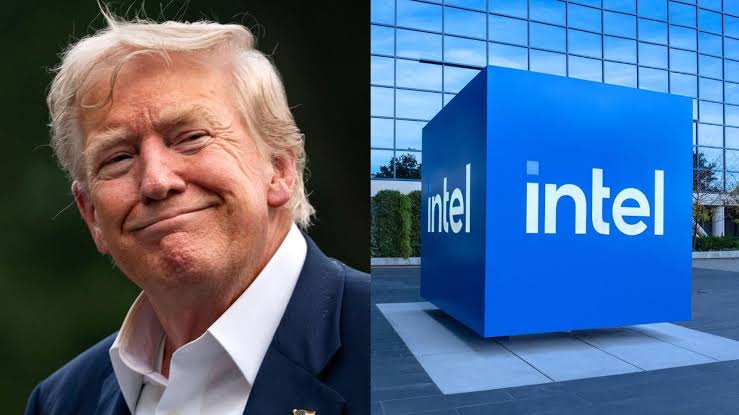President Donald Trump announced on Friday that Intel has agreed to give the United States government a 10% ownership stake in the company.
The agreement followed a White House meeting last week between Trump and Intel’s Chief Executive Officer, Lip Bu Tan. This came shortly after Trump publicly demanded Tan’s resignation over concerns regarding his past financial ties to Chinese technology firms.
“I suggested that it would be beneficial for the United States to become Intel’s partner,” Trump told reporters. “He agreed and now the deal is done.”
Commerce Secretary Howard Lutnick confirmed the agreement on social media later that day. “The United States of America now owns 10% of Intel, one of our leading technology companies,” Lutnick wrote, describing the development as “historic” and a step toward securing America’s dominance in semiconductors. He also thanked Tan for finalizing an arrangement that he said was “fair to Intel and fair to the American people.”
Intel, which currently has a market valuation slightly above $100 billion, has been struggling to keep pace with competitors. The announcement came just days after Japan’s SoftBank revealed that it had raised its holding in Intel to about 2%.
Details of the Deal
According to Intel’s official statement, the government’s 10% stake valued at $8.9 billion was secured through previously approved federal grants that had not yet been disbursed. Specifically, $5.7 billion will come from the CHIPS and Science Act incentives program, while an additional $3.2 billion is being redirected from the Secure Enclave initiative.
In total, Washington will acquire 433.3 million Intel shares at $20.47 each, representing roughly 9.9% of the company’s equity.
Trump celebrated the development in a Truth Social post, writing: “It is my great honor to report that the United States now fully owns and controls 10% of Intel. We paid nothing for these shares, which are today valued at approximately $11 billion.”
Why Trump Pushed for the Deal?
Since the beginning of his second term, Trump has taken an aggressive approach toward reshaping the U.S. semiconductor industry. His administration has imposed a 15% levy on Nvidia and AMD for selling advanced chips in China, requiring the companies to pay the commission in exchange for export licenses.
Trump’s move to secure a stake in Intel is part of his broader push to strengthen domestic chip production and reduce America’s reliance on overseas supply chains particularly those in Asia. The administration views this as critical to preserving the United States’ technological advantage in artificial intelligence and national security.
Earlier this month, Trump pressured Tan to resign only months after his appointment as Intel’s CEO, citing national security concerns over Tan’s past investments in Chinese firms. However, Tan managed to retain his position after pledging loyalty to the U.S. in a letter to Intel staff and personally meeting with Trump at the White House. The president later praised him for his “remarkable story.”
Intel’s Struggles
Once a dominant force in the computer chip industry, Intel has faced significant setbacks. The company missed out on the mobile revolution following Apple’s iPhone debut in 2007 and has since fallen behind competitors in the artificial intelligence sector.
In 2023, Intel recorded losses of nearly $19 billion, with another $3.7 billion deficit in the first half of 2024. CEO Tan has since embarked on sweeping cost-cutting measures, including plans to reduce the company’s workforce by 25%, bringing it down to around 75,000 employees by year’s end.
Government Ownership: Not Entirely New
While unusual, federal ownership of private corporations is not unprecedented. During the 2008 financial crisis, the U.S. government acquired a 60% stake in General Motors after injecting about $50 billion to rescue the automaker from bankruptcy. That bailout ended with Washington incurring a $10 billion loss when it eventually sold off its holdings.
Lutnick emphasized in an interview with CNBC that the government has no intention of directly influencing Intel’s operations. The shares purchased are non-voting, meaning Washington cannot dictate company strategy. Still, some analysts warn that Intel’s new connection with the White House could encourage other corporations to increase chip orders in hopes of gaining political favor.
Intel’s Federal Funding
Intel has been one of the largest beneficiaries of the CHIPS and Science Act launched under President Joe Biden. However, despite receiving $2.2 billion of the $7.8 billion pledged, the company has struggled to accelerate its planned projects and regain competitiveness.
































